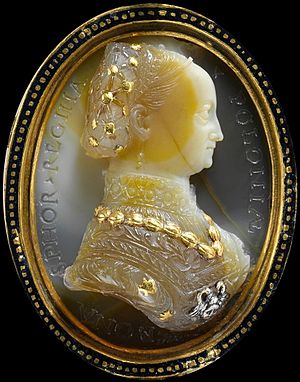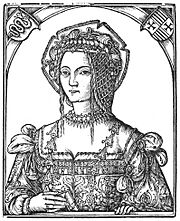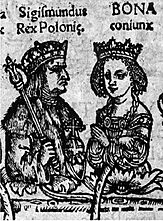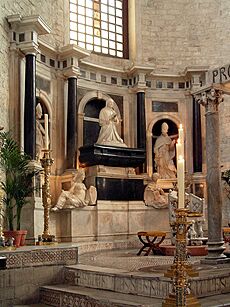Bona Sforza facts for kids
Quick facts for kids Bona Sforza |
|
|---|---|

Cameo with bust of Bona Sforza, c. 1540
|
|
| Queen consort of Poland Grand Duchess consort of Lithuania |
|
| Tenure | 18 April 1518 – 1 April 1548 |
| Coronation | 18 April 1518 Kraków, Poland |
| Duchess regnant of Bari | |
| Tenure | 11 February 1524 – 1557 |
| Predecessor | Isabella |
| Successor | None (annexed by Naples) |
| Born | 2 February 1494 Vigevano, Duchy of Milan |
| Died | 19 November 1557 (aged 63) Bari, Kingdom of Naples |
| Burial | Basilica di San Nicola |
| Spouse | |
| Issue Detail |
|
| House | Sforza |
| Father | Gian Galeazzo Sforza |
| Mother | Isabella of Aragon |
Bona Sforza (born February 2, 1494 – died November 19, 1557) was a very important Queen of Poland and Grand Duchess of Lithuania. She became queen by marrying Sigismund the Old, who was the King of Poland. Bona was also the Duchess of Bari and Rossano in Italy, which she inherited. She belonged to the powerful House of Sforza family, who ruled the Duchy of Milan.
Bona was known for being smart, energetic, and ambitious. She played a big role in the political and cultural life of the Polish–Lithuanian union. To help the country earn more money, she started many economic and farming changes. One of these was the Wallach Reform in Lithuania. In foreign policy, she made alliances with the Ottoman Empire and sometimes disagreed with the Habsburgs (a powerful European family). Her children later received money from a loan she gave to Philip II of Spain, which was never fully paid back.
Contents
Early Life and Education
Bona Sforza was born on February 2, 1494, in Vigevano, Italy. She was the third of four children born to Gian Galeazzo Sforza and Isabella of Naples. Her father was the rightful ruler of the Duchy of Milan. However, her great-uncle, Ludovico Sforza, took control of Milan. Bona's family had to move to a castle in Pavia, where her father died the same year she was born.
Later, Bona's family moved to the Sforza Castle in Milan. Her great-uncle Ludovico kept a close eye on them. To keep Bona's older brother, Francesco, from becoming too popular, Ludovico sent him away. Bona's mother was given the lands of Bari and Rossano. But then, a war started, and the King of France took over Milan. Bona's family had to leave Milan and move to Naples in 1500. The war followed them there, and they had to hide for a while on an island called Ischia.
By 1502, Bona was the only one of her siblings still alive. She and her mother settled in the Castello Normanno-Svevo in Bari. This is where Bona received an excellent education. Her teachers were famous Italian scholars who taught her many subjects. She learned mathematics, natural science, geography, history, law, Latin, classical literature, and even how to play musical instruments.
Marriage to a King
When the Sforza family regained control of Milan in 1512, Bona's mother hoped to arrange a marriage for her. Many important people suggested different husbands for Bona, including dukes and even a brother of the Pope. However, these plans didn't work out.
In 1515, the King of Poland, Sigismund I the Old, became a widower. The Holy Roman Emperor, Maximilian I, wanted Sigismund to marry someone who would be friendly to his family. He suggested Bona Sforza as one of the possible brides. Bona's old teacher and a diplomat traveled to Vilnius to convince King Sigismund to choose Bona. They succeeded!
The marriage agreement was signed in September 1517. Bona brought a very large dowry (money and goods) with her: 100,000 ducats in cash and 50,000 ducats worth of personal items. She also brought the Duchy of Bari as part of her inheritance. In return, King Sigismund gave her several towns in Poland.
The wedding ceremony, where someone stood in for the groom, took place on December 6, 1517, in Naples. Bona wore a beautiful light blue dress. Her journey to Poland took more than three months. Bona and Sigismund met for the first time on April 15, 1518, near Kraków.
Queen of Poland and Grand Duchess of Lithuania
Bona and Sigismund's wedding and coronation happened on April 18, 1518. The celebrations lasted for a whole week! From the very beginning of her life in Poland, the energetic Queen Bona wanted to have a strong political role. She started gathering supporters around her.
In 1519, Pope Leo X, who was a friend of Bona's from her time in Italy, gave her the power to choose people for important church positions in Poland. This was a very important power because it allowed her to gain the support of many officials. Three of her most trusted supporters were known as the "Triumvirate." Bona openly got involved in state affairs, which was unusual for a queen at that time. Even though she and the King sometimes disagreed on issues, their marriage was strong and successful.
Helping the Country
Bona believed that to make the royal family stronger, they needed more money. She worked hard to gather as much wealth as possible. This would give her husband the financial freedom to protect the kingdom without always needing the Parliament's slow approval. The royal family gained many lands in Lithuania. By 1536–1546, they had taken control of the Grand Duchy.
Bona also helped to change how farming was taxed. She introduced fair taxes for farmers and new ways to measure land. These changes brought in a lot of money for the kingdom.
Bona and Sigismund wanted to make sure their family, the Jagiellonian dynasty, would continue to rule Poland. They decided to have their only son, young Sigismund Augustus, recognized as the future king. First, the Lithuanian nobles accepted him as their duke around 1527–1528. Then, in 1529, he was crowned Sigismund II Augustus. This caused some disagreement among Polish lords. They decided that the next coronation would only happen after Sigismund Augustus died and with the agreement of all the nobles.
In 1539, Bona sadly had to oversee the burning of an 80-year-old woman named Katarzyna Weiglowa for her religious beliefs. However, after this event, Poland began to become more tolerant of different religions.
Working with Other Countries
Bona was very important in creating alliances for Poland. She had good relationships with the Vatican (the Pope's government). She also tried to keep good relations with the Ottoman Empire and even had contact with Hürrem Sultan, the wife of the Ottoman ruler. Many believe that the good relationship between the two queens helped save Poland from an attack by the Ottoman army during the Italian Wars.
Bona was worried about the growing ties between the Habsburgs and Russia. In 1524, King Sigismund signed an alliance with King Francis I of France to avoid fighting on two fronts. Bona helped set up this alliance, hoping to regain Milan. However, the alliance ended after Francis's army was defeated in 1525.
Even though they were related by blood, Bona sometimes strongly opposed the Habsburgs. She wanted to add Silesia to the Polish crown. She also successfully supported her son-in-law, John Zápolya, to become King of Hungary after the previous king died in battle in 1526. This was against the Habsburgs' wishes.
Supporting Arts and Culture
Bona, like her husband, was very interested in the rebirth of classical art and ideas, known as the Polish Renaissance. She brought famous Italian artists, architects, and sculptors to Poland. Her most famous projects included expanding the Palace of the Grand Dukes of Lithuania in Vilnius and building Ujazdów Castle. This castle had a large park and a place for animals. The plans for these buildings were made by Bartolomeo Berrecci da Pontassieve, who designed many other projects in Poland.
Queen Mother and Later Life
On April 1, 1548, King Sigismund I the Old died. His son, Sigismund Augustus, became the new king. Bona and her son had some disagreements, especially about his marriage to Barbara Radziwiłł, whom many nobles disliked. However, Bona eventually accepted her son's choice. Still, their relationship became difficult. After her husband's death, Bona moved with her unmarried daughters to Masovia and stayed there for eight years. Then, she moved back to Bari in Italy.
Loans and Death

In February 1556, Bona left Poland for her home country of Italy. She took with her many treasures she had collected over 38 years. In May, she arrived in Bari and took control of her mother's duchy. Soon, representatives from King Philip II of Spain visited her. They tried to convince her to give up her duchies of Bari and Rossano to Spain.
Bona agreed to lend a huge amount of money, 430,000 ducats, to the Duke of Alba, who was the ruler of Naples for Spain. This loan was meant to help him raise money for troops. The agreements were signed in September and December 1556.
However, the Habsburgs (the Spanish royal family) wanted to get Bari and did not plan to pay back the loan. On November 8, Bona became ill with a stomach ache. On November 17, as she was losing consciousness, her trusted courtier Gian Lorenzo Pappacoda brought a notary to her. The notary wrote down her last will. In this will, she left Bari and other lands to Philip II of Spain. She also left large sums of money to Pappacoda's family. Her daughters would receive a one-time payment, except for Isabella Jagiellon, who would get money every year. Her son, King Sigismund II Augustus, was named as the main heir, but he would only inherit cash, jewelry, and other personal items.
The very next day, Bona felt better. She dictated a new will that left Bari and her other properties to her son, Sigismund Augustus.
Bona died early in the morning on November 19, 1557, at the age of 63. Many suspected she was poisoned by people in her own household. She was buried in the Basilica di San Nicola in Bari. Her daughter, Anna Jagiellon, later had a beautiful tomb built for her there in the Renaissance style.
Children of Bona Sforza
Bona Sforza had seven pregnancies during the first nine years of her marriage. Her children included:
- Isabella (1519–1559): She married John Zápolya, who was the King of Hungary.
- Sigismund II Augustus (1520–1572): He became King of Poland and Grand Duke of Lithuania after his father.
- Sophia (1522–1575): She married Henry V, Duke of Brunswick-Lüneburg.
- Anna (1523–1596): She later became Queen of Poland and Grand Duchess of Lithuania herself.
- Catherine (1526–1583): She married John III of Sweden.
- Albert (born and died 1527): He was born prematurely and died at birth.
See also
 In Spanish: Bona Sforza de Milán para niños
In Spanish: Bona Sforza de Milán para niños
- Chicken War
- Neapolitan sums
Images for kids
|
Bona Sforza
House of Sforza
Born: 2 February 1494 Died: 19 November 1557 |
||
| Royal titles | ||
|---|---|---|
| Preceded by Barbara Zápolya |
Queen consort of Poland Grand Duchess consort of Lithuania 1518–1548 with Elisabeth of Austria (1543–1545) |
Succeeded by Barbara Radziwiłł |
| Italian nobility | ||
| Preceded by Isabella of Aragon |
Duchess of Bari Princess of Rossano 1524–1557 |
Annexed by Naples |








